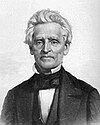Disciples of Christ (Campbell Movement)
The Disciples of Christ (Campbell Movement) were a group arising during the Second Great Awakening of the early 19th century.
[1]: 117 When their study of the New Testament led the reformers to begin to practice baptism by immersion, the nearby Redstone Baptist Association invited Brush Run Church to join with them for the purpose of fellowship.
"[2]: 86 Thomas' son Alexander immigrated to the US to join him in 1809, and before long assumed the leading role in the movement.
"[3]: 106 Among practices he rejected as non-essential were "the holy kiss, deaconesses, communal living, footwashing and charismatic exercises.
"[3]: 80 The essentials he identified were those practices for which the Bible provided "a 'Thus saith the Lord,' either in express terms or by approved precedent.
"[3]: 81 Unlike Locke, who saw the earlier efforts by Puritans as inherently divisive, Campbell argued for "a complete restoration of apostolic Christianity.
[5]: 114 Alexander Campbell was also deeply influenced by Enlightenment thinking, in particular the Scottish School of Common Sense of Thomas Reid and Dugald Stewart.
[3]: 84 Alexander Campbell reflected this approach, when arguing that "the Bible is a book of facts, not of opinions, theories, abstract generalities, nor of verbal definitions.
[3]: 84, 85 Thomas Campbell combined the Enlightenment approach to unity with the Reformed and Puritan traditions of restoration.
First, it provided the idea that Christian unity could be achieved by finding a set of essentials that all reasonable people could agree on.
[6]: 6 He had more confidence in the potential for human progress and believed that Christians could unite to transform the world and initiate a millennial age.
[6]: 6 Campbell's conceptions were postmillennial, as he anticipated that the progress of the church and society would lead to an age of peace and righteousness before the return of Christ.
[2]: 116–120 [7]: 28 [8]: 212 [9]: xxi [10]: xxxvii This was formalized at the High Street Meeting House in Lexington, Kentucky with a handshake between Barton W. Stone and "Raccoon" John Smith.
[1]: 153–154 Many believed the union held great promise for the future success of the combined movement, and greeted the news enthusiastically.




